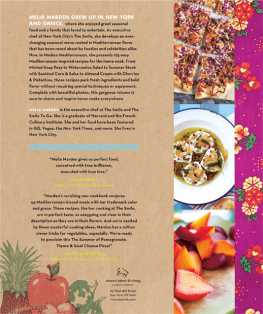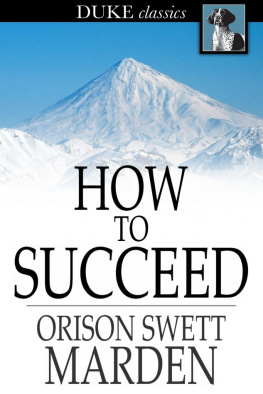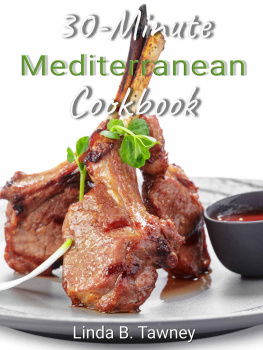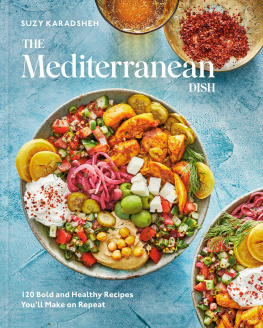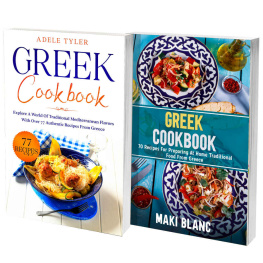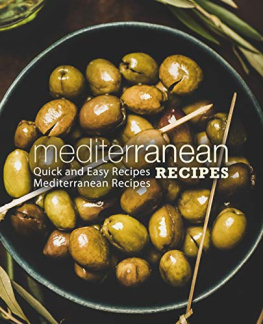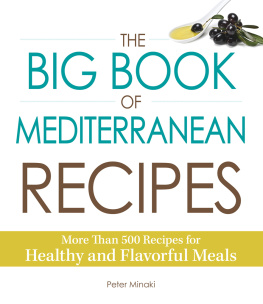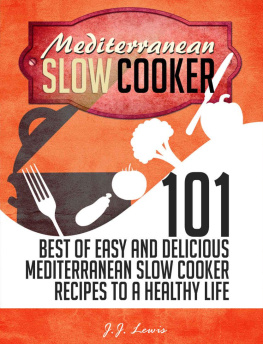


Published in 2013 by Stewart, Tabori & Chang
An imprint of ABRAMS
Text copyright 2013 Melia Marden
Photographs copyright 2013 Lucy Schaeffer
All rights reserved. No portion of this book may be reproduced, stored in a retrieval system, or transmitted in any form or by any means, mechanical, electronic, photocopying, recording, or otherwise, without written permission from the publisher.
Library of Congress Cataloging-in-Publication Data
Marden, Melia.
Modern Mediterranean / Melia Marden.
pages cm
Includes bibliographical references.
ISBN 978-1-61769-018-1
1. Cooking, Mediterranean. I. Title.
TX725.M35M384 2013
641.591822--dc23
2012036375
EDITOR: Natalie Kaire
DESIGNER: Laura Palese
MANAGING EDITOR: Jen Graham
PRODUCTION MANAGER: True Sims
FOOD STYLING: Simon Andrews
PROP STYLING: Amy Wilson
Stewart, Tabori & Chang books are available at special discounts when purchased in quantity for premiums and promotions as well as fundraising or educational use. Special editions can also be created to specification. For details, contact specialsales@abramsbooks.com or the address below.

115 West 18th Street
New York, NY 10011
www.abramsbooks.com

THE OLD FERRY that you used to take from Athens (long since replaced by higher-speed hydrofoils)



I WOULDNT BE A PROFESSIONAL CHEF TODAY IF IT WERENT FOR MY MOTHER, not only because she was an amazing cook, but also because she created a life for her family in which delicious food was a constant, valued presence. Throughout her life she had an innate urge to travel. She spent her childhood in Williamsport, Pennsylvania, and as soon as she graduated from college she took a summer job as a flight attendant on a small charter airline, flying to Europe and North Africa. Skip ahead to the 1970s. After moving to New York City and meeting my father, her lifelong wanderlust led her to the small rocky island of Hydra, Greece. Though only two hours from Athens, Hydra seems to belong to another time: A strictly enforced law prohibits any kind of car or vehicle; donkeys, wooden fishing boats, and now water taxis provide the main forms of transportation. Drawn to the eccentric community of foreigners living cheaply in this idyllic, sun-drenched landscape, my mother decided to make Hydra a permanent part of her life. She returned with my father the next year, eventually buying an old farmhouse in the hills of Kamini, four hundred winding stone steps up from the main port.
Ive been lucky enough to spend almost every summer of my life in that house. During falls and winters in New York City, I would dream about the rustic island cooking at Hydras pristine seafront tavernasperfectly charred whole fish and rosemary-rubbed lamb chops right off the grill, intensely sweet red onions with ripe tomatoes topped with tangy feta, and delicately fried zucchini dipped in potent, garlicky tzatziki. Returning to Hydra every year was like a culinary homecoming; I never tired of its food, even after weeks of crisp salads and grilled fish. It was there that I internalized the hallmark of great Mediterranean cooking, a kind of simplicity thats perfectly balancedthe flavors of clean, fresh ingredients playing off one another so that you are able to taste everything at once.

MY MOM on a picnic boat (mid-90s)
Back home in New York, I was fortunate enough to grow up surrounded by a vibrantly international culinary culturethe Greek tavernas in Astoria echoing my experiences on Hydra with their grilled red snapper and lemony olive oil; the Moroccan spices and fresh kaffir-lime leaves at specialty groceries like Kalustyans in Murray Hill; and the family-run Italian shops in Greenwich Village selling handmade mozzarella, fresh tortellini, and crushed tomatoes. Sometime in the early 1980s, my mom took a Moroccan cooking class with the now legendary cookbook author Paula Wolfert. The influence of that class and subsequent trips to Morocco formed the backbone of our family meals. Our traditional Christmas dinner became a deliciously aromatic chicken, preserved lemon, and cracked green olive tagine, accompanied by a giant bowl of fluffy couscous topped with simmered winter vegetables. If Greek food can be characterized by the bold saltiness of olives and capers, Moroccan food has the darker, earthier sweetness of dates, cinnamon-scented onions, and preserved lemons. Without realizing it, I was developing the tastes that would shape my cooking for years to come.
Like many people, I loved food without ever seriously considering it as a profession. Cooking seemed like the backdrop of my life, not the center. I went to college, studied art history, and found myself with a post-graduation sense of aimlessness. But as with so many things in life, the answer I was looking for was right in front of me. While assisting part time at a magazine, I did background research on up-and-coming chefs for an article about the next Martha Stewart (she had just been found guilty of insider trading and was heading to prison). I felt a rising sense of jealousy that these people were doing something so directly gratifying, working with their hands, creating delicious food that could be instantly appreciated. Having had no professional cooking experience, and not a lot of amateur experience either, I immediately enrolled in culinary school. Six months later, my friend Meredith and I started a company called Looking Glass Catering, booking jobs through friends and cooking out of a kitchen the size of a bathtub in my apartment on East Tenth Street. At that point, we were making it up as we went along. I took other food-related jobs as wellworking as a private chef for a family, interning at a fledgling food magazine, and assisting a food writer with recipe testing. Right from the beginning, I never looked back; I loved that cooking had become my world and that I was interacting with it every day. Fortunately, I still love having a job that allows me to never stop learning. Every time I eat somewhere new or try something different, I can be inspired by ingredients, techniques, and combinations that had never occurred to me before.
In 2008 my friend Carlos asked me to check out his new project, a caf on the ground floor of a historic 1830s Bond Street townhouse, just one block away from my apartment in New York. Coincidentally, it was the first building my parents had lived in together after they got married. It must have been a sign, as one thing led to another and, soon after, Carlos and his business partner, Matt, asked me to design the menu and be the executive chef at The Smile. None of us had ever run a restaurant; I myself had just barely worked in one before, and only for a few months. The building was old and had obviously never been designed for any kind of food operation. The kitchen was awkward and tiny, with no ventilation or gas hookup. In the end, the limitations helped me create a more personal, low-key menu of foods that felt home cooked and that fit with the relaxed atmosphere of the space. While we learned a few things the hard way (not having air-conditioning in August that first year was definitely a low point), eventually everything fell into place.
Next page
